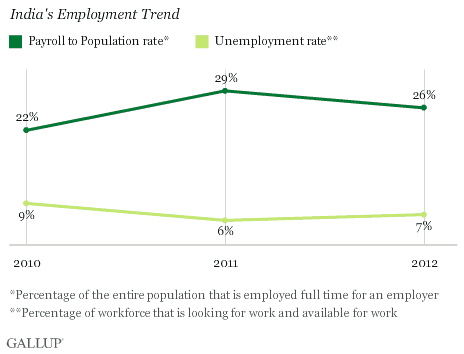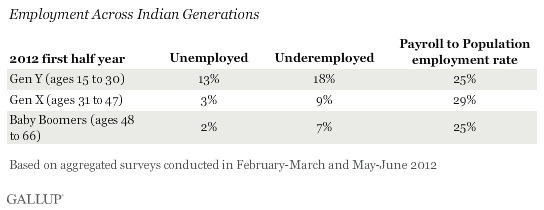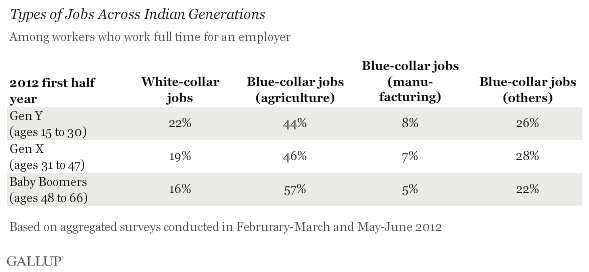WASHINGTON, D.C. -- About one in four Indian adults (26%) were employed full time for an employer in the first half of 2012, according to Gallup's new Payroll to Population metric. The percentage of Indians with these good jobs is still up from where it was two years ago, but it provides little strong evidence that India's sluggish economy is firmly on the mend.

Gallup's Payroll to Population measure estimates the percentage of the entire aged 15 and older population -- not just those currently in the workforce -- who are employed full time for an employer for at least 30 hours per week. This measure provides a clear-cut indicator of employment that is not affected by shifts in the size of the workforce and is highly correlated with GDP. The metric does not count adults who are self-employed, working part time, underemployed, unemployed, or out of the workforce as payroll employed.
Young Indians More Likely to Be Unemployed and Underemployed
While the working-age population shrinks in advanced countries and neighboring economic powerhouse China, Gallup's data reinforce that India's still burgeoning young population is not used to its economic potential. Indians between the ages of 15 and 30 are as likely as their older counterparts to be employed full time for at least 30 hours per week, but they are nearly five times more likely to be unemployed and twice as likely to be underemployed.

However, there are some positive signs for young Indians. More than one in five (22%) young Indians who work full time for an employer report working in white-collar jobs -- defined as professional workers in fields such as business or education -- making them at least somewhat more likely to have these types of typically higher paying jobs than older generations of workers.

Further, the majority of young Indians who work full time for an employer report working in blue-collar type jobs -- in fields such as manufacturing, agriculture, or other industries -- but they are less likely to be employed in agriculture than older Indians. While less than 10% of jobs for all age groups are in manufacturing, this is a potential area for growth particularly with the large-scale rural-urban migration going on in India.
Implications
By some estimates, as many as 300 million young Indians are expected to enter the workforce by 2025 -- meaning the problem with high youth unemployment and underemployment in India is only likely to get worse. Goldman Sachs research in 2010 projected that India's industries would need to create nearly 40 million jobs by the end of this decade to absorb this influx of young people into its labor force.
Job creation focused on manufacturing -- which currently makes up about 16% of India's GDP -- could be instrumental in reaping this youth demographic dividend. To this end, India's government launched the National Manufacturing Policy in 2011 to increase the share that manufacturing contributes to India's GDP by 25% in a decade and create 100 million jobs in the process. The Gallup findings make clear that the potential payoff for India's economy would be significant if more Indians -- and especially more young Indians -- are able to secure full-time employment. The youth demographic dividend alone, according to an International Monetary Fund report, is expected to contribute two percentage points to India's annual per-capita income growth in the next 20 years.
For complete data sets or custom research from the more than 150 countries Gallup continually surveys, please contact us.
Survey Methods
Results are based on face-to-face interviews with approximately 5,000 adults, aged 15 and older, conducted each year in India. Results for 2012 are aggregated results combining the first two quarters in 2012. For results based on the total sample of national adults, one can say with 95% confidence that the maximum margin of sampling error is ±1.7 percentage points. For results based on the Indian adults who are employed full time for an employer for at least 30 hours per week, one can say with 95% confidence that the maximum margin of sampling error is ±2.9 percentage points. The margin of error reflects the influence of data weighting. In addition to sampling error, question wording and practical difficulties in conducting surveys can introduce error or bias into the findings of public opinion polls.
For more complete methodology and specific survey dates, please review Gallup's Country Data Set details.
